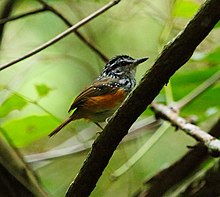
Dysithamnus is a genus of insectivorous passerine birds in the antbird family, Thamnophilidae. Species in this genus are known as antvireos.
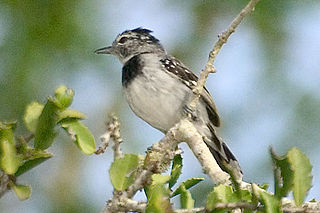
Herpsilochmus is a genus of insectivorous passerine birds in the antbird family (Thamnophilidae). They are found in forest, woodland and shrub in South America, although a single species the rufous-winged antwren also occurs in Panama. All are relatively small antbirds that are sexually dichromatic. In most species males are essentially light grey with a black crown and black-and-white wings, while females are more buff or rufous with black-and-white crown.
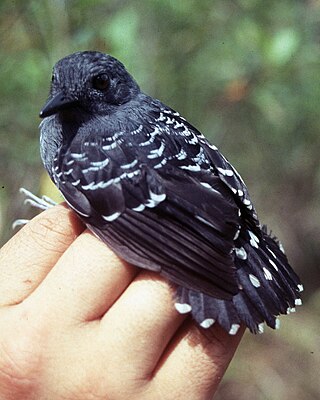
The common scale-backed antbird is a species of passerine bird in subfamily Thamnophilinae of family Thamnophilidae, the "typical antbirds". It is found in Bolivia, Brazil, Colombia, Ecuador, French Guiana, Guyana, Peru, Suriname, and Venezuela.

The warbling antbird is a complex consisting of six species of antbirds that until recently were considered a single species found throughout the Amazon in South America. Based on vocal differences and to a lesser degree differences in plumages, it has been recommended treating them as separate species:

The yellow-browed antbird, or yellow-browed antwarbler, is a species of bird in subfamily Thamnophilinae of family Thamnophilidae, the "typical antbirds". It is found in Brazil, Colombia, Ecuador, and Peru.

Hypocnemoides is a genus of passerine bird in the antbird family, Thamnophilidae. It contains two species, the black-chinned antbird and the band-tailed antbird. They are found in swampy areas of northern South America. There is limited overlap in their distributions with the band-tailed antbird occurring to the south of the Amazon River and the black-chinned antbird mainly found to the north. They are fairly small birds, 11.5–12 cm in length, with a short tail and longish bill. Their plumage is grey with areas of black and white. They forage for food near water in the understorey or on the ground. The name Hypocnemoides is a combination of the genus name Hypocnemis and -oides.

Myrmoborus is a genus of passerine birds in the antbird family, Thamnophilidae.

Percnostola is a genus of insectivorous passerine birds in the family Thamnophilidae.

The fire-eyes, Pyriglena, are a genus of birds in the antbird family Thamnophilidae.The genus contains 5 species, all found in South America. The fire-eyes are 16–18 cm in length, weigh 25-36 g and have characteristic red eyes that give them their name. They have sexually dimorphic plumage, with the females possessing brown to buff coloured bodies with black tails, and the males being black with small patches of white on the back or wings. The fire-eyes eat a variety of insects, and will regularly follow army ants in order to catch prey flushed by them. Two of the fire-eyes are widespread and safe, but one species, the fringe-backed fire-eye, is threatened with extinction.

Terenura is a genus of insectivorous passerine birds in the antbird family, Thamnophilidae.

Thamnomanes is a genus of insectivorous birds in the antbird family, Thamnophilidae. They are restricted to the Neotropics and are important components of forest mixed-species feeding flocks.

The Guianan warbling antbird, or Guianan antwarbler, is an insectivorous bird in subfamily Thamnophilinae of family Thamnophilidae, the "typical antbirds". It is found in Brazil, French Guiana, Guyana, Suriname, and Venezuela.

The Imeri warbling antbird or Imeri antwarbler, is a species of bird in subfamily Thamnophilinae of family Thamnophilidae, the "typical antbirds". It is found in Brazil, Colombia, and Venezuela.
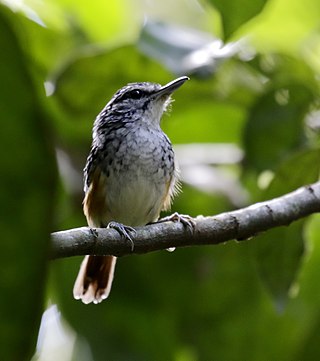
The Peruvian warbling antbird or Peruvian antwarbler, is a species of bird in subfamily Thamnophilinae of family Thamnophilidae, the "typical antbirds". It is found in Bolivia, Brazil, Colombia, Ecuador, and Peru.
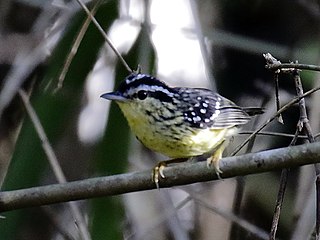
The yellow-breasted warbling antbird or yellow-breasted antwarbler, is a species of bird in subfamily Thamnophilinae of family Thamnophilidae, the "typical antbirds". It is found in Bolivia, Brazil, and Peru.
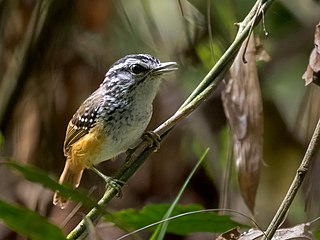
Spix's warbling antbird or Spix's antwarbler, is a species of bird in subfamily Thamnophilinae of family Thamnophilidae, the "typical antbirds". It is endemic to Amazonian Brazil.

The Rondonia warbling antbird or Rondonia antwarbler, is a Vulnerable species of bird in subfamily Thamnophilinae of family Thamnophilidae, the "typical antbirds". It is found in Bolivia and Brazil.

The Xingu scale-backed antbird is a species of bird in subfamily Thamnophilinae of family Thamnophilidae, the "typical antbirds". It is endemic to Brazil.

The Manicore warbling antbird or Manicore antwarbler, is a species of insectivorous bird in subfamily Thamnophilinae of family Thamnophilidae, the "typical antbirds". It is endemic to Brazil.
